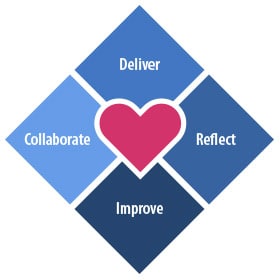It has been a two-year roller coaster for several businesses, both thriving and surviving. With change as the only certainty in the future, businesses face the challenge of sustaining a more efficient and better model.
The solution lies in creating business agility. It is only possible to achieve this if an organization’s values and behaviors reinforce the agile culture. Imagine empowering individuals to be more creative, adaptable, and resilient. This will allow better preparation for the complexity and uncertainty of our new working future, as these behaviors will be transferred into the business.
What is an agile business? We hear the term “agile” thrown around a lot, but what does it mean? And why is it so important in today’s business world?
We’ll explore the anatomy of an agile business. We’ll look at the different components that make up an agile structure and how they work together to create a functional company. At the end, you’ll know all about how to go about building your own agile business!

An agile business adapts to change and thrives off of it.
Agile is a mindset, not just a way of doing business. It’s about change and adaptation. It’s about embracing change and letting it flow through the organization as smoothly as possible.
In an agile company, your employees have the freedom to make decisions on their own without having to go through a bureaucratic process or wait for permission from above. This kind of autonomy is essential in today’s rapidly changing environment where change happens quickly and often unexpectedly.
Agile companies don’t have “one true way” of doing things; they’re open to new ideas from anyone at any level within the organization because everyone there has been trained to think creatively about how we can constantly improve our products and services on behalf of our customers.
Being an agile organization means embracing a certain mindset and business culture, no matter how uncomfortable that may be.
If you want your company to be agile, it’s important to have a certain mindset and business culture. You need to be open-minded and willing to take risks, because that is how innovation happens. You also need a willingness to fail—if you are trying something new but it doesn’t work out, then you have learned something valuable that can help you improve the next time.
An agile team is a group of people with different skill sets who share information and work together toward the same goals. Team members are committed to the goals of the team and accountable for their own performance. They are open to criticism, and willing to learn from mistakes.
Team members must be able to communicate effectively with each other, including being able to tell others what they need or want without being confrontational (soft skills). Their goal is not just reaching consensus on a single plan but also reaching consensus on how they will collaborate going forward (process).
Agile culture creates a safe environment for ideation and innovation.
Agile culture is a set of values that creates a safe space for innovation and ideation. These values form the foundation of an agile culture and can be used to align the team with the business in an effective manner. Below are some examples of how you can use these values to improve your business:
- Communication – It’s important for teams working in agile environments to have regular dialogue with each other, as well as those outside their team. This helps create trust among employees, which will lead them down more productive paths when resolving conflicts or issues within projects or products.
- Respect – Treating coworkers with respect means making sure no one feels threatened by anything said or not said during discussions about work-related matters; it also means treating employees with dignity at all times regardless of their position within an organization (i.e., manager vs . worker).

It can be hard to tell the difference between a successful opportunity and a failure. Take advantage of opportunities aggressively.
In agile businesses, opportunities are everywhere. The right people and ideas are always in the right place at the right time.
For example, if you have a product that’s been out for several years, an agile company will be constantly looking for ways to improve it and make it better. That means they may reach out to customers and ask them what they would like changed or added. This could lead to a new feature being added as a result of customer feedback—the result is both an improvement on your current offering as well as an opportunity for more revenue generation!
In another example, let’s say you’re trying to decide which kind of software application should be installed in your office next year because there are several options available all with different features and pricing structures but not all of them meet your needs completely (for example: one software package might be cheaper but doesn’t integrate well with other systems). You could take this opportunity by researching each option further so that when the time comes around again next year when there’s another decision which one works best then we’ll know exactly what those requirements are going into negotiation rather than making assumptions based off past experiences.
Embrace new technology to enhance your business and get comfortable with it.
Agile businesses are constantly adapting to changes in technology. It is important to keep up with the latest and greatest so you can capitalize on its benefits.
For example, cloud computing has allowed for businesses to operate more efficiently and at lower costs than ever before. Cloud computing gives you access to advanced applications that have been designed specifically for your industry, making it easier than ever before for companies to manage their operations without having to invest in costly software or hardware infrastructure.
Maintain your talent despite work environment changes.
You might be thinking: “Why do I need to change my environment? My employees are happy with where they are at!” But if you want to remain competitive in the marketplace, it’s important that you take steps now before it becomes too late.
There are many things businesses can do when trying to retain their talent by changing their business environment; here are some examples:
- Provide job training programs for employees who want more skills development opportunities (e-learning courses).
- Encourage cross-training between departments so employees gain new skillsets (developers learning about marketing strategy).
- Implement flexible work arrangements like telecommuting or job sharing.
Final thoughts
Agile is a philosophy that can be applied to any industry, but it’s especially important for businesses that are dependent on technology.
It’s up to you whether or not you want your business to adapt agile principles, but if you do decide it’s right for you then there are several things that need to happen first: You need a solid understanding of what being an agile organization means and how it benefits everyone involved; then, you have to adopt the mindset and culture needed for success within an agile framework. Finally, don’t forget about those changes—it takes time before they become routine!
Contact us to learn more tips on how to adapt agile principles to your business:
info@globalis.com





